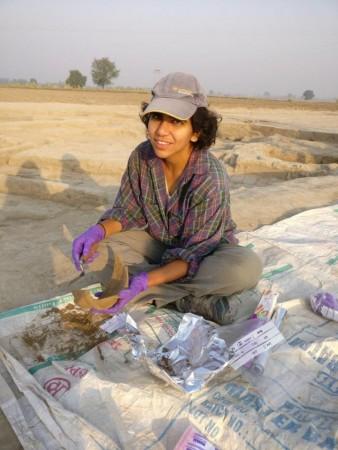Researchers found new lipid residue in pottery of ancient Indus Civilization leading to conclude that the meat of animals like pigs, cattle, buffalo, sheep and goat as well as dairy products, was heavily consumed in both rural and urban settlements in north-west India, the present-day states of Haryana and Uttar Pradesh.
The study, published in the Journal of Archaeological Science, was led by Dr Akshyeta Suryanarayan, former Ph.D. student at the Department of Archaeology, University of Cambridge and current postdoctoral researcher at CEPAM, UMR7264-CNRS, France.

As lipids are relatively less prone to degradation, the pottery from archaeological excavations often helps scientists to determine the eating habits of ancient civilizations. In the case of Indus Valley Civilization, very limited investigation in ancient ceramics from South Asia has been conductd.
"This study is the first to investigate absorbed lipid residues in pottery from multiple Indus sites, including the Indus city of Rakhigarhi, as well as other Indus settlements of Farmana and Masudpur I and VII, allowing comparisons to be made across settlements and across time," she noted.
Meat residue
The identification of specific compounds in the lipid extracts and isotopic analysis of fatty acids enabled the researchers to identify several types of animal meat and milk and how they were cooked by the people of Indus Valley Civilization.
"Some of the results were quite unexpected, for example, we found a predominance of non-ruminant animal fats, even though the remains of animals like pigs are not found in large quantities in the Indus settlements. It is possible that plant products or mixtures of plant and animal products were also used in vessels, creating ambiguous results," Suryanarayan said.
Despite the high percentages of the remains of domestic animals found at these sites, there is very limited direct evidence of the use of dairy products in vessels. A recent Scientific Reports study has also reported more evidence of dairy products, primarily in bowls in Gujarat, she said. "Our results suggest that there may have been regional differences. The analysis of more vessels from different sites would help us explore these potential patterns," explained Suryanarayan.

Senior author Dr. Cameron Petrie, University of Cambridge, said the climatic instability after 4.2 ka BP (c.2100 BC) could have changed the diet habits of the Indus Civilization.
"There is also evidence that rural settlements in northwest India exhibited a continuity in the ways they cooked or prepared foodstuff from the urban (Mature Harappan) to post-urban (Late Harappan) periods, particularly during a phase of climatic instability after 4.2 ka BP (c.2100 BC), which suggests that daily practices continued at small rural sites over cultural and climatic changes," Petrie said.
This study has major implications for broadening our understanding of the foodways of South Asia, as well as the relationship between pottery and foodstuffs. However, more studies are required to establish the results, combined with other techniques in bioarchaeology, the environment, foodstuffs, material culture, and ancient society in protohistoric South Asia, said the study authors.

















